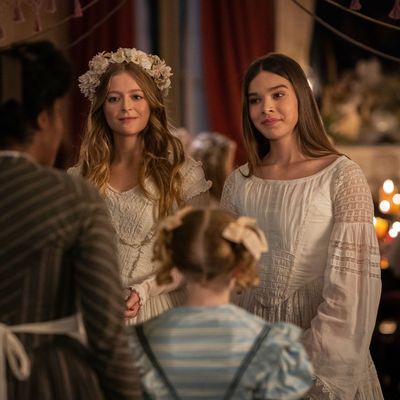
There’s a running joke in season two ofDickinson,a little returning bit that never amounts to all that much in the grand scheme of things but is a great example of the show’s sincere but Surrealist sense of humor. Emily’s sister, Lavinia (Anna Baryshnikov), who spent much of season one lurking resentfully in Emily’s shadow, steps into her own a bit more. She’s more aware of her sexuality, more interested in defining her life by something other than becoming a younger model of her mother, and she develops a relationship with a young man who rents a room in the Dickinson home, Henry “Ship” Shipley (Pico Alexander). Lavinia likes him, but she becomes especially intrigued by something he mentions offhandedly — that he once had a relationship with a woman named Lola Montez, who was known for doing a particularly compelling spider dance.
Lavinia becomes a little obsessed with Lola Montez, and it becomes a gag throughout the season. Ship mentions Lola occasionally, and every time Lavinia hears the name, her eyes get a little unfocused, like she’s having a Lola hallucination. There’s a music cue whenever they mention Lola, the strumming sound of Spanish guitars. Lavinia wants to know all about Lola — what the dance was like, what Ship did with her, what kind of a woman Lola was. It’s pureDickinson,an odd little mention that comes back and back, escalating until eventually Lavinia’s dressing up and dancing and the whole thing feels goofy and also weirdly intense.
It should not have surprised me that Lola Montez was a real person, given how muchDickinsonloves to play with a legit historical reference. But Montez was a legendary and scandalous figure from the 19th century, a woman whose reputation was so well known and fiery that her exploits were covered in newspapers around the world. Knowing that, Lola Montez becomes so much more than just an odd little returning joke inDickinson.She’s an ideal key to so many of the undercurrents in season two, which is often weirder and shaggier than season one. But it’s also a wholehearted embrace of big, ambitious, messy ideas about fame and notoriety and what it means to have a legacy, and Lola Montez sits right at the center ofallof that.
I’m ashamed that I didn’t even think to look up Lola until I asked Anna Baryshnikov about Lavinia’s obsession with her. “She was a real woman,” Baryshnikov told me. “And she was an Irish woman who adopted this name and persona for herself. What she was really known for was this spider dance where she would pretend that a spider had gotten under her skirt and would end up lifting her skirt and showing her bare… bare everything below the waist. It was this famously seductive act that drove men crazy.”
Lola Montez (born Eliza Gilbert in Connacht, Ireland) lived a remarkable life. She invented a Spanish identity for herself, created a notorious theater routine that scandalized audiences from Europe to Australia, and, according toan accountfrom the 1950s, had lovers who included “army officers, British nobility, a German prince, a French journalist, a pimp, a rich merchant, Franz Liszt, and King Ludwig I of Bavaria.” (As made-up Spanish personas go, Hilaria Baldwin wishes she got this much done.) Lola married more than once, was proximal to a handful of strange sudden deaths, she heckled her audiences, inspired a satire play about her life, and theDaily Alta Californiafrom 1888reportedthat while she didn’t shoot Henry Shipley, she did attack him with a whip.
Lola Montez makes all kinds of sense as an icon of freedom for Lavinia, who spends most of season two getting comfortable with sexuality and trying to imagine a life where she’s not purely subservient to a husband. “Having Lavinia hear about this woman who seems to have so much more power than she does,” Baryshnikov said, “often it’s hard to find that power within ourselves. So [Lavinia is] playing at how it might feel to be someone like that.”
But outside of Lavinia’s story, season two ofDickinsonis wrapped up in one central obsession: Should Emily Dickinson pursue fame? Should she let the newly arrived newspaper editor Samuel Bowles (Finn Jones) read all her poems and publish them? Is her art better when it’s only for her (and maybe also Sue, who Emily still loves passionately)? As with season one, they’re questions thatDickinsonis explicitly posing about Emily’s life, but they’re also questions that it’s aiming straight at its 21st-century audience. My colleague Jackson McHenry described this as an “extremely online” season of TV, and he’s right — every arrowDickinsonaims at questions about audience and privacy and artistry in Dickinson’s life is also pointed squarely at the show’s audience. It’s explicitly asking whether artistry is the cost of fame. It’s wild and a little dizzying to watch that play out on a majorPeabody Award–winningtelevision production that inspiresintense fandomand rampant memes, but it’s also a question the show takesveryseriously.
There is one way that Lola as a small running gag falls out of step withDickinsonseason two’s larger project. The show’s not interested in probing the uncomfortable self-made exoticization of Lola’s legacy, but it is heavily invested in poking at the questions of fame and notoriety for the Black Amherst residents who gather in the barn right next to the Dickinsons’ house. They’re publishing an abolitionist newspaper, and while Emily imagines books of her poetry sitting on a shelf, servants Henry (Chinaza Uche) and Hattie (Ayo Edebiri) are debating whether they’d even want to use their own names in the abolitionist newspaper they’re writing. Should they turn themselves into gimmicks in order to make white audiences more comfortable? Should their newspaper be dedicated to serious essays only, or can Hattie write something more explicitly entertaining?
The easy answer to these questions about the cost of recognition is that fame, however useful it might be, is also poisonous, whichDickinsontakes directly from Dickinson’s own work. Dickinson’s poem “Fame Is a Fickle Food,” which features prominently in the season, concludes that “men eat of it and die.” There’s also “Fame Is a Bee”and “I’m Nobody! Who Are You?,”whichDickinsontranslates into a persistent haunting that follows Emily through the season, forcing her to stare directly at her fear of being forgotten.
But Lola Montez offers another answer for the problem of fame, and it’s one that’s just as alive inDickinsonseason two, even if it’s hidden inside Lavinia’s fantastically goofy spider-dance obsession. Lavinia sees Lola as an inspiration, someone who has demonstrated a way to live that Lavinia had no idea was possible for women. “Coming at it from how small the Dickinsons’ life is,” Baryshnikov told me, “you can imagine Emily and Lavinia really only having their house and their town as their concept of the world.” Lola is a glimpse at a much, much bigger world out there, one that’s a huge, terrifying, thrilling, scandalous mess of sexy dancing and whipping newspaper editors in the street.
None of that is possible without Lola Montez’s fame. In the same breath, none of the thousands of rapturous fans obsessed with a 19th-century poet and her love affair with her sister-in-law is possible withoutDickinson,a TV show whose starhas millions of Instagram followersand whose awards exist ontheir own separate Wikipedia page.All of that contradiction — the poison and possibility of fame — is alive inDickinson,and it’s encapsulated in Lola Montez, a woman renowned for, and stuck inside, the legacy of her celebrity.





